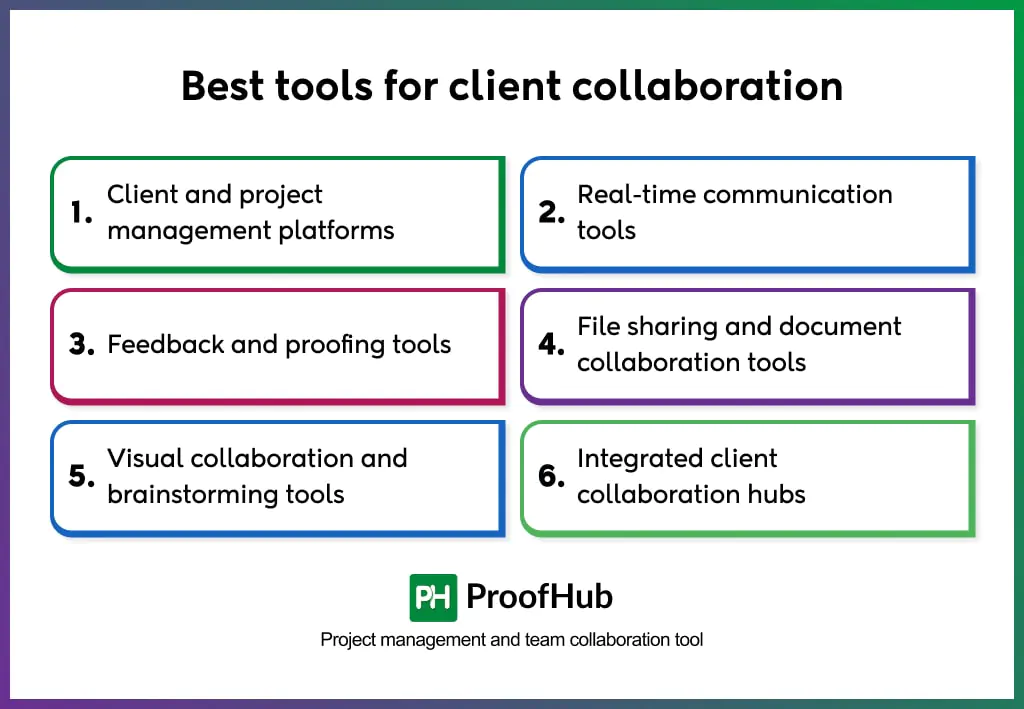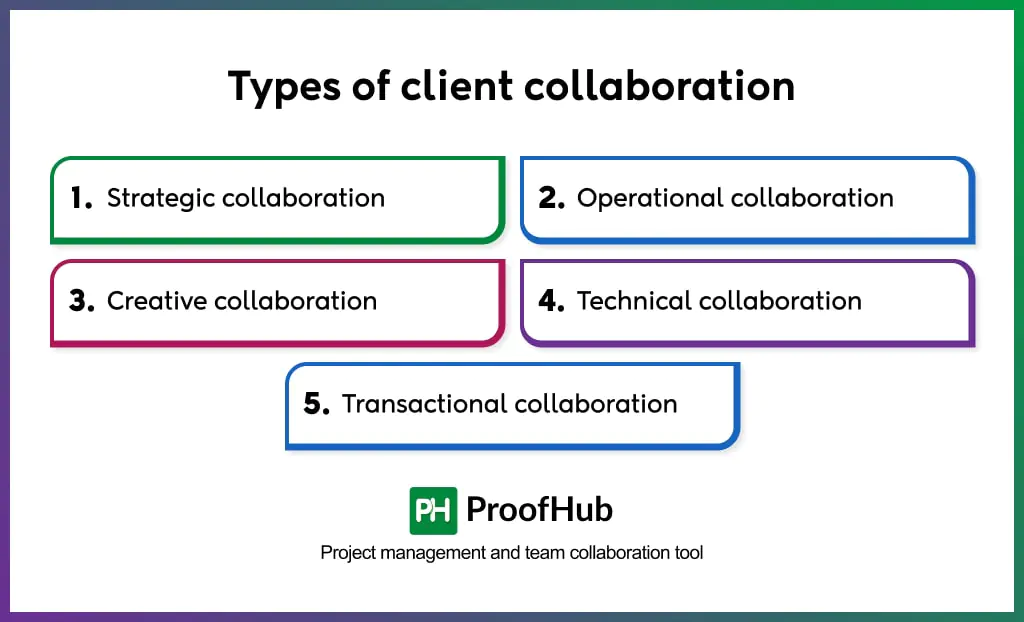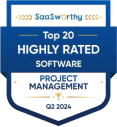
Client collaboration is the process of working jointly with clients to share information, align goals, and deliver successful project outcomes through transparency, communication, and mutual accountability. It nurtures long-term partnerships where both sides actively contribute to decision-making, feedback, and progress tracking.
Effective collaboration with clients enhances clarity, reduces miscommunication, and increases the accuracy of deliverables by keeping teams and clients aligned at every stage of a project. It builds trust, accelerates approvals, and ensures that business outcomes match client expectations.
Organizations rely on structured client collaboration to maintain visibility, standardize communication, and create consistent experiences across projects. It is essential for agencies, service providers, and product teams that manage complex client engagements across distributed environments.
In this article, we discuss what client collaboration is, why it matters, its key elements, strategies to improve it, challenges to overcome, and the best tools that help teams collaborate effectively with clients.
What is client collaboration?
Client collaboration is the process of working jointly with clients to exchange information, communicate effectively, and achieve shared project or business goals. It transforms client relationships from transactional exchanges into strategic partnerships built on mutual accountability.
Clients actively participate in defining objectives, reviewing progress, and approving deliverables. This involvement aligns expectations early and minimizes the gap between planned outcomes and actual results.
Client collaboration relies on communication, visibility, and feedback. Communication ensures clarity of requirements and updates. Visibility gives clients access to project timelines, task ownership, and deliverable status through centralized dashboards. Feedback closes the loop by validating quality and guiding adjustments before final delivery.
Why is client collaboration important?
Client collaboration is important because it aligns expectations, enhances transparency, and ensures projects meet client objectives efficiently. It creates a shared environment where decisions are data-driven, communication is clear, and outcomes are measurable.
When clients participate throughout the project lifecycle, they provide immediate feedback that minimizes misunderstandings and rework. This reduces delays, improves accuracy, and increases the likelihood of first-time approval on deliverables.
Collaboration establishes trust and accountability. Open visibility into project timelines, milestones, and progress reports keeps clients informed, building confidence in the team’s process and commitment. This trust accelerates decision-making and strengthens long-term business relationships.
Strong collaboration improves client retention and satisfaction. Clients who are heard and involved renew contracts, expand partnerships, and refer to new businesses. It transforms service delivery into a joint value creation process rather than a one-time transaction.
What are the key elements of client collaboration?
The key elements of client collaboration are shared visibility, structured communication, secure information exchange, defined access control, feedback loops, client enablement, and proactive partnership.

These elements allow teams and clients to work together effectively, maintain trust, and deliver results with consistency and clarity.
- Shared visibility and task transparency: Shared visibility ensures that clients have continuous access to project timelines, progress updates, and deliverables. It eliminates uncertainty by allowing both sides to monitor the same information in real time, creating transparency and accountability.
- Structured communication: Structured communication provides an organized system for discussions, approvals, and updates. Dedicated communication channels, such as chat, video calls, or meeting logs, keep all information accessible and prevent message fragmentation across emails or informal platforms.
- Secure information exchange: Secure information exchange safeguards client data through encrypted document sharing, version control, and controlled access. It builds confidence that sensitive materials are handled responsibly, which is essential for compliance and trust.
- Defined access control: Access control determines who can view, edit, or approve documents, ensuring that collaboration remains organized and secure. Role-based permissions prevent errors, protect confidentiality, and maintain clear boundaries within shared workspaces.
- Feedback loops: Feedback loops enable two-way communication that keeps collaboration adaptive and aligned. Continuous feedback minimizes rework, ensures deliverables meet expectations, and creates a structured rhythm of review and improvement.
- Client enablement: Client enablement focuses on equipping clients with knowledge, context, and tools to participate meaningfully. Educational materials, onboarding sessions, and documentation help clients make informed decisions and contribute effectively to discussions.
- Proactive partnership: Proactive partnership goes beyond execution; it involves anticipating client needs, identifying opportunities, and offering solutions before problems arise.
Strategies to improve client collaboration
To improve client collaboration, remove communication barriers, maintain response consistency and speed, prioritize communication clarity, grant controlled dashboard access, filter client-facing information, loop relevant team members into client communication, provide regular progress documentation, implement transparent time tracking for billing.

Read these strategies in much detail below:
1. Remove communication barriers
Create multiple accessible channels for clients to reach without friction. Provide various contact options—email, call, messaging platforms—and ensure clients know exactly how to connect with you. Make responding to your communications equally straightforward by including, clear reply mechanisms in every interaction.
2. Maintain response consistency and speed
Delayed or unpredictable responses affect trust and disrupt project momentum. Establish and honor a response standard—ideally within 24 hours for routine matters, faster for urgent issues. Consistent adherence to this commitment demonstrates reliability and strengthens client confidence in your partnership.
3. Prioritize communication clarity
Ensure every communication is direct, easy to interpret, and uses terminology your client understands. Ambiguous messaging confuses and undermines collaboration. Address high-priority concerns first, avoid jargon, and verify that your intent comes through clearly to prevent misinterpretation.
4. Grant controlled dashboard access
Bring clients into your project management environment as observers. Most collaboration platforms allow guest access where clients can view project status, timelines, and task progress without editing capabilities. This visibility keeps them informed and engaged without risking accidental changes to critical project elements.
5. Filter client-facing information
Filter what clients see to focus on meaningful progress rather than overwhelming them with preliminary drafts or internal discussions. Most clients appreciate understanding overall direction and status without needing granular operational details.
6. Establish and deliver on milestones
Define clear milestones throughout the project timeline and ensure your team consistently meets them. Each completed milestone reinforces momentum and demonstrates measurable advancement toward the final goal.
7. Loop relevant team members into client communications
Clarity starts with ensuring the right people receive the right information. Include task owners in client correspondence through CC or direct inclusion. When team members hear directly from clients, they better understand requirements and context, reducing interpretation errors and back-and-forth clarifications.
8. Provide regular progress documentation
Keep clients continuously informed through scheduled updates—weekly or monthly, depending on project scope. Share progress reports, relevant data, and supporting files that give clients a comprehensive view. This ongoing transparency makes clients feel like active partners rather than passive observers.
9. Implement transparent time tracking for billing
Billing disputes damage relationships. Eliminate ambiguity by using time tracking tools that log hours spent on client tasks, creating an auditable record. Give clients access to view these logs so they can see exactly how their investment translates to work effort, building trust through complete transparency.
What are the challenges of client collaboration?
The challenges of client collaboration include communication barriers, unclear expectations, decision making delays, trust issues, cultural and language barriers, payment and budget concerns.

Learn about these challenges in much details align with the ways to address them effectively:
1. Communication barriers
Misunderstandings often arise when client might not respond promptly, provide unclear feedback, or misunderstand technical explanations. This leads to missed updates, delayed feedback, and frustration on both sides.
Address this by defining clear communication protocols – set preferred channels, update frequency, and points of contact. Use centralized tools for discussions and maintain shared summaries to ensure both parties are aligned.
2. Unclear expectations and goals
Clients may have different ideas about deliverables, timelines or outcomes than what was discussed. This often begins from assumptions left unspoken or vague initial agreements, leading to disappointment and conflict down the line. To prevent this, document project scopes, milestones, and approval criteria early on. Revisit and validate expectations during key checkpoints to ensure continued alignment.
3. Decision making delays
When clients take too long to approve work, provide necessary information, or make critical decisions. This often happens when multiple stakeholders are involved or when clients are juggling competing priorities.
Solve this by using proofing or feedback management tools that collect comments in one place. Structured feedback cycles and version control help avoid confusion and ensure quick turnarounds.
4. Trust issues
Some clients micromanage or second-guess every decision due to past negative experiences or lack of understanding about your process. Building confidence takes time and consistent delivery.
Create visibility into your workflow through regular updates, shared project dashboards, and documented methodologies. When clients see the “how” behind your work, they’re less likely to micromanage.
5. Cultural or language barriers
Differences in work culture, business practices, or language can lead to misunderstandings about everything from meeting etiquette to project priorities.
Use visual communication for written or verbal communication with diagrams or mockups. This transcends language barriers and reduces misinterpretation.
6. Payment and budget concerns
Disagreements over costs, late payments, or requests for work beyond budget create tension and can strain even good relationships.
Address budget issues early. If a client requests work beyond budget, immediately present options to either reduce scope elsewhere, extend the timeline, or increase the budget.
Best tools for client collaboration
Effective client collaboration relies on digital platforms such as project collaboration platforms, real-time communication tools, feedback and proofing software, document collaboration tools, and visual collaboration platforms that centralize communication, manage approvals, streamline feedback, and provide real-time visibility across client projects.

Here are some of the best tools for client collaboration:
- Client and project management platforms: These platforms bring clients and internal teams into one workspace to plan, assign, and review tasks together. They enable structured communication, document sharing, and milestone tracking. Some examples include ProofHub, Basecamp, and Wrike.
- Real-time communication tools: Instant communication tools such as Slack, Microsoft Teams, and Zoom keep information flowing smoothly between clients and teams. Features like chat channels, group threads, and video calls support quick decisions and transparent discussions without relying on long email chains.
- Feedback and proofing tools: Online proofing tools allow clients to review designs, documents, or campaigns, annotate directly, and approve changes efficiently. Solutions like ProofHub and Filestage make the feedback cycle traceable and organized, preventing version confusion and communication gaps.
- File sharing and document collaboration tools: Secure document collaboration platforms, such as Google Workspace, Dropbox, and OneDrive, ensure that both clients and teams access the latest versions of shared resources. They provide version control, co-editing, and easy retrieval of project materials.
- Visual collaboration and brainstorming tools: These tools allow distributed teams and clients to co-create ideas, map workflows, or visualize campaign structures. Digital whiteboards like Miro and FigJam replicate live collaboration sessions, making ideation faster and more interactive for both sides.
- Integrated client collaboration hubs: All-in-one platforms such as ProofHub consolidate multiple tools like task management, file sharing, chat, time tracking, and reporting into a unified workspace. Such integration reduces tool fatigue, improves visibility, and simplifies client engagement across every stage of delivery.
What are the types of client collaboration?

Client collaboration can be categorized by strategic, operational, creatiive, technical, and transactional collaboration. They are defined by how teams and clients interact to plan, execute, and evaluate projects. Each type reflects a different level of client involvement, communication frequency, and decision-sharing.
- Strategic collaboration: Involves clients as long-term partners in planning and goal-setting. Clients contribute to product direction, campaign strategy, or business outcomes. It focuses on shared KPIs, innovation, and market alignment rather than individual deliverables.
- Operational collaboration: Centers on workflow execution. Clients engage in project planning, task approvals, and milestone reviews through collaboration dashboards or project management platforms. It ensures efficiency, accountability, and transparent progress tracking.
- Creative collaboration: Applies to design, content, and marketing projects where clients provide iterative feedback. Tools like proofing systems or version control software support review cycles and ensure that client input refines quality without disrupting timelines.
- Technical collaboration: Common in software or IT environments, where clients participate in feature testing, sprint planning, and feedback integration. This form relies on structured communication tools, real-time updates, and versioned deliverables.
- Transactional collaboration: Occurs in service-based engagements where collaboration is limited to approvals, deliverables, and billing communication. It emphasizes clarity, timeliness, and documentation rather than deep integration.
Along with these types, there are more variations based on the type of client such as B2B collaboration, B2C collaboration, agency-client collaboration, freelancer-client collaboration, and enterprise client collaboration.
How to foster a culture of client collaboration?
To build a culture of client collaboration, integrate transparency, shared accountability, and open communication into every stage of the client relationship. It shifts collaboration from task-based interaction to a partnership model focused on mutual success.
- Establish clear communication channels: Using centralized tools like collaboration tools or shared dashboards ensures both teams work from the same data source, eliminating ambiguity.
- Set mutual goals and success metrics: Shared goals align internal and client-side teams. When both measure progress using shared KPIs such as delivery time, feedback response rate, or satisfaction scores, collaboration becomes outcome-driven rather than process-heavy.
- Encourage proactive feedback and co-creation: Consistent collaboration helps clients contribute ideas early in the process. This reduces revisions, improves trust, and builds ownership of outcomes.
- Promote consistency and visibility: Regular review meetings, milestone check-ins, and post-project evaluations reinforce that collaboration is ongoing, not situational.
- Reinforce culture: Celebrate client wins, acknowledge contributions, and integrate learning from feedback loops into new projects. This continuous alignment builds loyalty and long-term partnerships.
What role does feedback play in client collaboration?
In client collaboration, feedback acts as a validation and correction mechanism by establishing alignment between client expectations and project outcomes. It ensures that every iteration whether a design, campaign, or deliverable, matches client objectives before final approval, reducing rework, enhances satisfaction, and accelerates decision-making cycles.
Effective feedback cycles strengthen trust, increase transparency, and make clients active contributors instead of passive evaluators. This shared accountability improves delivery quality and builds long-term relationships.





